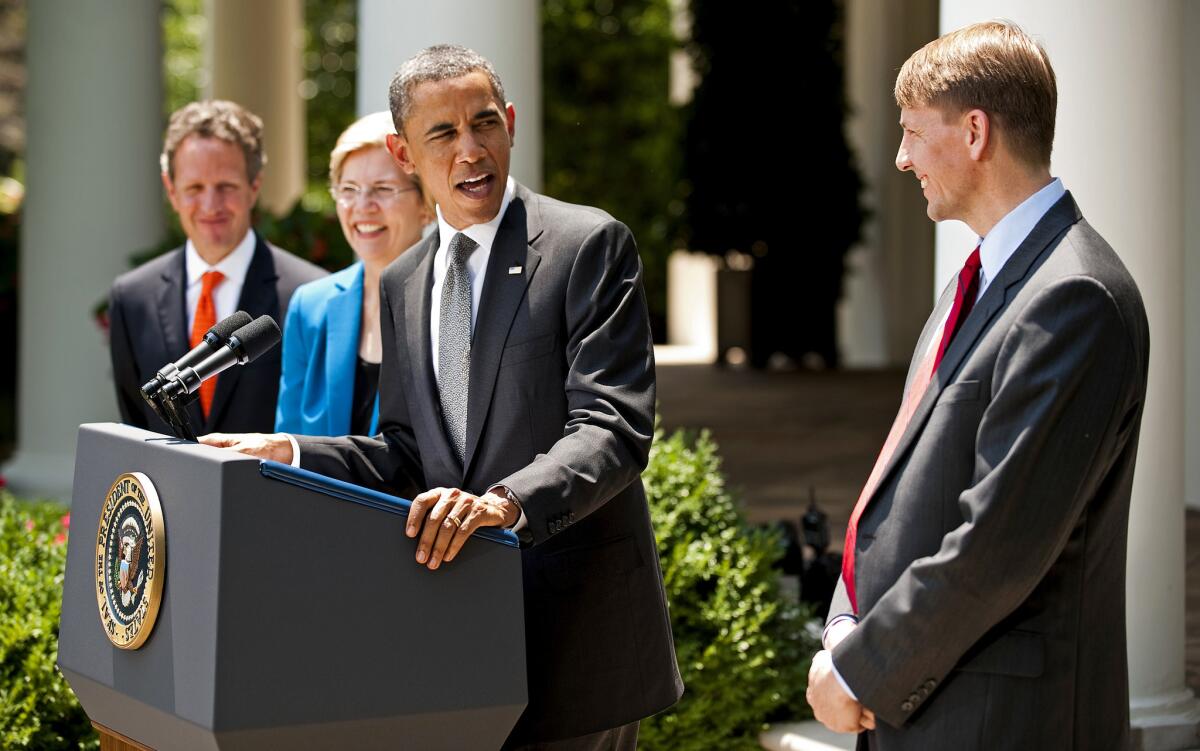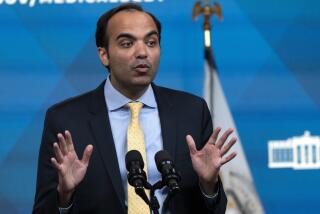Obama’s consumer protection legacy defined by aggressive agency

Bill Doak and his wife, Linda, were preparing to buy a new house this spring when a mortgage broker made an ominous declaration after scanning their credit report: “Oh my God, you’re in trouble.”
The couple discovered five late payments on the loan on the home they were selling in Springfield, N.H. That threatened to cost them at least a percentage point more in interest for a mortgage in their native Connecticut, where they planned to retire.
Doak, 63, said he quickly identified the source of the trouble: a snafu last year when their servicer, Nationstar Mortgage, gave them incorrect information about the timing of an escrow increase.
Fixing the problem was much more difficult. After at least 15 calls to Nationstar in a month with no progress, Doak went to an attorney who filed a six-paragraph online complaint with the Consumer Financial Protection Bureau.
“Within five days the thing was resolved,” Doak said of reaching out to the agency. “What they did for me was just simply amazing.”
Launched in the wake of the 2008 financial crisis, the bureau is one of President Obama’s signature accomplishments.
If one toaster out of a thousand toasters explodes, their view is get rid of all the toasters.
— Travis Norton, executive director. U.S. Chamber of Commerceâs Center for Capital Markets Competitiveness
It is emblematic of an aggressive approach to consumer protection that has led to record numbers of automobile recalls, a crackdown on financial fraud scams and a slew of new regulations covering a wide swath of businesses, including healthcare providers, food manufacturers, retirement planners and high-speed Internet service providers.
“I think you have to consider him a tremendous president for consumers,” said Ed Mierzwinski, consumer program director at the U.S. Public Interest Research Group.
That also has made the Obama administration a tremendous target for business leaders and industry trade groups, which view its approach to consumer protection as heavy-handed and paternalistic. They say that has harmed the economy and has led to fewer choices for Americans.
“This administration’s view of consumer protection is to limit the number of consumers who have access to a product,” said Travis Norton, executive director of the U.S. Chamber of Commerce’s Center for Capital Markets Competitiveness. “If one toaster out of a thousand toasters explodes, their view is get rid of all the toasters.”
For all his activism, Obama wins surprisingly few points on consumer protection issues among some liberals, who grouse that no major Wall Street executives have been sent to prison for the actions that led to the 2008 financial crisis. And some auto safety advocates complain that federal regulators haven’t been tough enough on manufacturers for dangerous vehicle and part defects.
But the greatest controversy has been generated by what supporters and opponents describe as the most sweeping and potentially long-lasting consumer protection initiative of the Obama years -- the creation of the Consumer Financial Protection Bureau.
The brainchild of Sen. Elizabeth Warren (D-Mass.) when she was a law professor, the bureau was the centerpiece of the 2010 Dodd-Frank overhaul of financial regulations and the first new federal agency since the early 1970s that was focused specifically on American consumers.
It took over and expanded on consumer protection duties that were spread among several other financial regulators after they were lambasted for not doing more to prevent subprime mortgage abuses.
In the nearly five years since opening its doors, the independent consumer bureau has issued regulations covering mortgages, payday loans, debt collection, arbitration clauses and for-profit colleges, among other things.
The bureau said it has handled more than 800,000 complaints through a new online database and has obtained $11.2 billion in refunds and other relief for more than 25 million consumers through enforcement actions.
“If people are violating the law they should be made to pay,” Richard Cordray, the bureau’s director, said at a Senate Banking Committee hearing in April. “They should be made to reimburse consumers who are harmed.”
Cordray was lectured by the panel’s chairman, Sen. Richard Shelby (R-Ala.), and other Republicans for going too far.
“There is now growing concern that despite the bureau’s mission, its rules and regulations actually restrict access to credit, increase cost and deny financial products to the consumers who need them,” Shelby said. “Consumer protection should not mean limiting a consumer’s options by … substituting the bureau’s judgment for the consumer’s.”
Congressional Republicans have tried unsuccessfully to advance dozens of bills to reduce the bureau’s authority and such efforts would top the GOP wish list if the party retains control of Congress and retakes the White House.
On May 17, Donald Trump, the presumptive Republican presidential nominee, said he was drawing up plans to dismantle nearly all of Dodd-Frank, which he called a “very negative force.”
Democrats are prepared to fight to preserve the bureau.
“We will continue to defend the work that’s done there and the agency, and resist attempts to roll back something that we think that has just been incredibly important,” Treasury Secretary Jacob J. Lew said.
The creation of the bureau “is an enormous achievement in terms of consumer protection,” said David Vladeck, a Georgetown University law professor and consumer protection expert.
From 2009-12, Vladeck headed the Federal Trade Commission’s Bureau of Consumer Protection. He said his hiring showed Obama’s commitment to consumer protection.
“Only in this administration would I have been offered a job,” said Vladeck, who had worked 27 years as a lawyer for public interest group Public Citizen.
At the commission, he co-chaired the Financial Fraud Enforcement Task Force, a multi-agency effort launched by Obama in 2009 that has led to more than 18,000 financial fraud cases filed by the Justice Department.
The creation of the Consumer Financial Protection Bureau was a big help in the effort, Vladeck said.
“The CFPB adds resources in terms of sophisticated lawyers and investigators who can go after complicated scams,” he said.
Norton, of the U.S. Chamber of Commerce, said the consumer bureau’s design insulates it from needed congressional oversight.
The agency gets its funding directly from the Federal Reserve, so it does not need to go to lawmakers for money. And the director, once confirmed by the Senate, serves a five-year term. That has led to “a very bold and sometimes boorish approach” to regulation, Norton said.
The chamber has supported Republican legislation to subject the bureau’s funding to the annual congressional appropriation process and replace the director with a bipartisan commission with staggered terms. Obama and his fellow Democrats have argued that would slow its ability to enact regulations and allow congressional opponents to starve the agency of funding.
Todd J. Zywicki, a George Mason University law professor and coauthor of the 2014 book “Consumer Credit and the American Economy,” said he supported the idea of consolidating all federal consumer protection responsibility in one agency.
But the bureau under Cordray has gone too far and needs to be reined in, he said.
“The CFPB has taken the approach that all consumers are basically hapless sheep to be shorn by the lending industry and have not understood that many consumers are not idiots,” Zywicki said.
But Roger Phillips, an attorney in Concord, N.H., said the bureau has been “a great benefit to the consumer.”
“Now the little guy has a voice,” Phillips said.
Doak, the New Hampshire homeowner, said he went to Phillips, who specializes in consumer law, after getting frustrated trying to solve his credit report problem.
“I talked to every supervisor that I think Nationstar had with absolutely no fix,” Doak said.
Nationstar said that it could not comment on specific customer cases, but added that its own tracking of complaints to the company showed a 60% decrease since 2014.
The consumer bureau created a public complaint database in an effort to pressure businesses to treat customers better.
In the most recent monthly report, covering December through February, Nationstar was the subject of the 10th most complaints to the bureau, with a monthly average of 283. The figure was down 17% from the same period a year earlier.
Consumer advocates have praised the bureau’s database for helping hold businesses accountable. The U.S. Chamber of Commerce and other industry groups have complained that the database is misleading because it can contain incorrect allegations or faulty conclusions by consumers.
Before the bureau’s creation, Phillips said it would have taken 30 to 45 days, or longer, to resolve a dispute such as Doak’s. But companies now respond quickly to complaints sent to them from the bureau.
“Without that letter to the consumer protection bureau, I don’t think this issue would have been resolved,” Doak said. “They did their job.”
Times staff writer Don Lee contributed to this report.
ALSO
Surge of migrant sailings has Italy scrambling to house thousands of new arrivals
Fired hospital worker’s case points to a trail of stolen drugs and thousands of patients at risk
Follow @JimPuzzanghera on Twitter
More to Read
Inside the business of entertainment
The Wide Shot brings you news, analysis and insights on everything from streaming wars to production — and what it all means for the future.
You may occasionally receive promotional content from the Los Angeles Times.











